What to Know About Sargassum in the Dominican Republic
Learn what sargassum is, where it shows up, and when to expect it, how resorts keep beaches clean, tips, and alternatives for a great Dominican Republic trip.
PRACTICAL INFO & RESOURCES
6/28/20258 min read
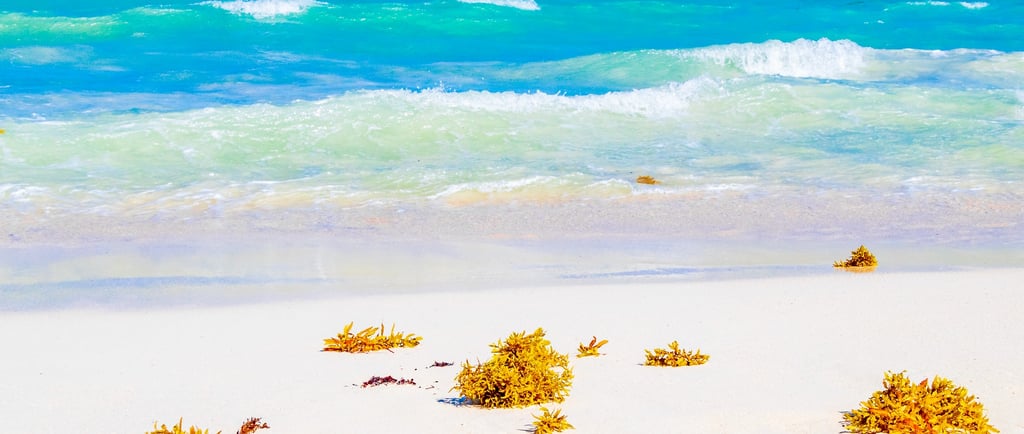

If you're dreaming of sunny beaches and turquoise water in the Dominican Republic, you might have heard about sargassum. It’s a type of seaweed that sometimes washes up along the shore. While it’s a natural part of the ocean and helps support marine life, too much of it can affect how the beach looks and smells.
This guide will help you understand what sargassum is, when and where it usually shows up, and how you can still enjoy your trip even during seaweed season. With a little planning, you can make the most of your beach vacation.
✅What Is Sargassum?
Sargassum is a naturally floating seaweed found mostly in the Atlantic Ocean and Caribbean Sea. It often gathers in large patches that drift with the currents. While it's completely normal in the ocean, too much of it can pile up on the beach, creating an unpleasant look and smell. Although it's safe to be near, the buildup can make beach areas less enjoyable for swimming, walking, and yes—even snapping those perfect Instagram photos.
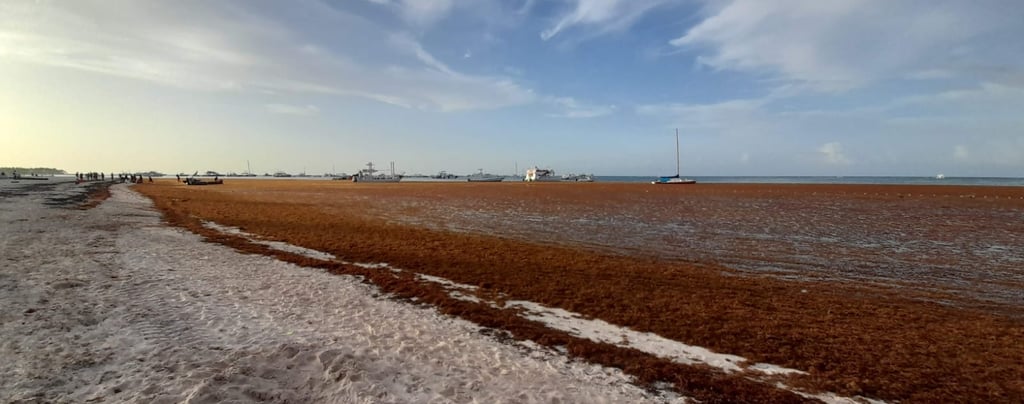

✅Facts About Sargassum
It's a Floating Habitat for Ocean Life
Sargassum is a type of seaweed that floats on the ocean’s surface. It creates a safe home for fish, crabs, shrimp, and baby sea turtles. It’s like a small moving island that helps marine life grow and survive.
It’s Been Around for Centuries
Sargassum has been floating in the Atlantic Ocean for a long time. Even during his voyage in 1492, Christopher Columbus saw large patches of it in what is now called the Sargasso Sea.
It Helps Make Oxygen
Like other plants, sargassum uses sunlight to make energy through photosynthesis. This process also produces oxygen, which helps keep ocean life healthy.
Sargassum Blooms Are Getting Bigger
In recent years, massive amounts of sargassum have started appearing more often. These huge “blooms” stretch across the Atlantic and into the Caribbean. Experts believe it’s caused by warmer ocean water, river pollution, and wind patterns.
It’s Not Dangerous, But It Can Smell Bad
Sargassum in the ocean is harmless. But when too much of it washes onto the beach and starts to rot, it can release a gas that smells like rotten eggs. This can cause mild irritation for some people, especially those with asthma or allergies.
It’s a Big Cleanup Job
Some beaches in the Dominican Republic and other Caribbean islands spend a lot of money and time removing sargassum. It can hurt tourism if the seaweed isn’t cleaned up regularly.
Sargassum Can Be Recycled
Instead of throwing it away, some places use sargassum to make eco-friendly products. It can be turned into fertilizer, animal feed, bioplastics, biofuel, and even building bricks.
It Helps the Planet
Sargassum also captures carbon dioxide from the air. When it sinks to the bottom of the ocean, it stores this carbon naturally, helping reduce climate change effects.
✅When Can You Expect Sargassum in the Dominican Republic?
Sargassum season typically runs from March to November, peaking in the summer months. During this time, warmer ocean currents and nutrient-rich waters encourage the growth of this seaweed, leading to increased amounts along Caribbean coastlines.
The winter months (December to February) are usually free of sargassum, making it the ideal time for beach lovers who want picture-perfect shores without any interruptions.
✅Where Is Sargassum Most Common in the Dominican Republic?
Sargassum doesn’t show up the same way on every beach in the Dominican Republic. It mostly depends on the time of year, wind, ocean currents, and where the beach is located. Some places get a lot of it during the summer, while others stay clean all year.
If you want to enjoy the best beaches without seaweed, it’s helpful to know which areas are affected the most—and which ones are better during sargassum season.
Beaches with the Most Sargassum
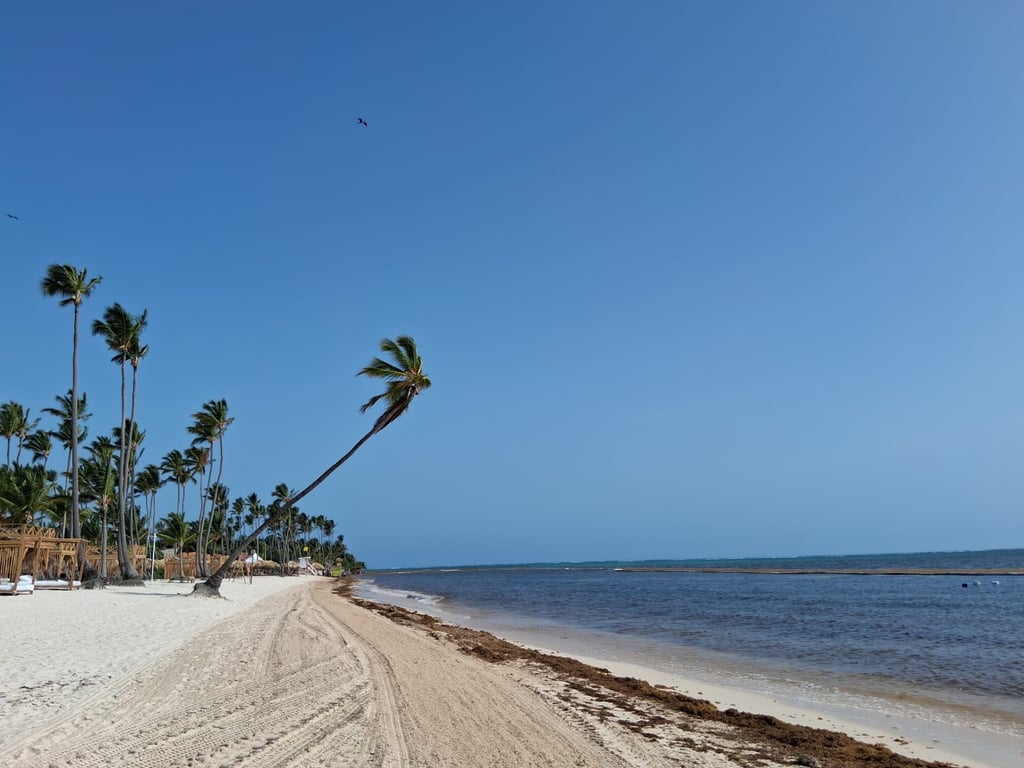

Punta Cana & Bávaro (East Coast)
These beaches are beautiful and popular, but they also get the most sargassum. That’s because they face the Atlantic Ocean, where the seaweed comes from.
Cabeza de Toro is one of the beaches closest to the eastern tip of the island. It’s near the Punta Cana International Airport and very open to the ocean, so it often gets the most sargassum.
Arena Gorda and Uvero Alto are farther north but still face the Atlantic, so they can also see a lot of seaweed, especially during the summer.
Macao Beach, on the other hand, is more protected by the shape of the coastline and usually has little to no sargassum, even during peak season. It’s a great alternative if you’re visiting in the summer months.
Before you book your resort, it’s smart to check exactly where it’s located. Looking it up on Google Maps can help you understand what part of the coastline you’ll be staying on, how close you are to the beach, and what the nearby area is like.
An easier way? Just scroll to the map section on your hotel’s listing at Booking.com. Use it to compare locations, check reviews, and make sure you're picking the perfect spot for your trip.
Start exploring now: Booking.com
Beaches with Less or No Sargassum
If you want to enjoy a beach vacation without worrying about seaweed, consider these regions of the Dominican Republic. They typically experience little to no sargassum, even during peak seaweed season.
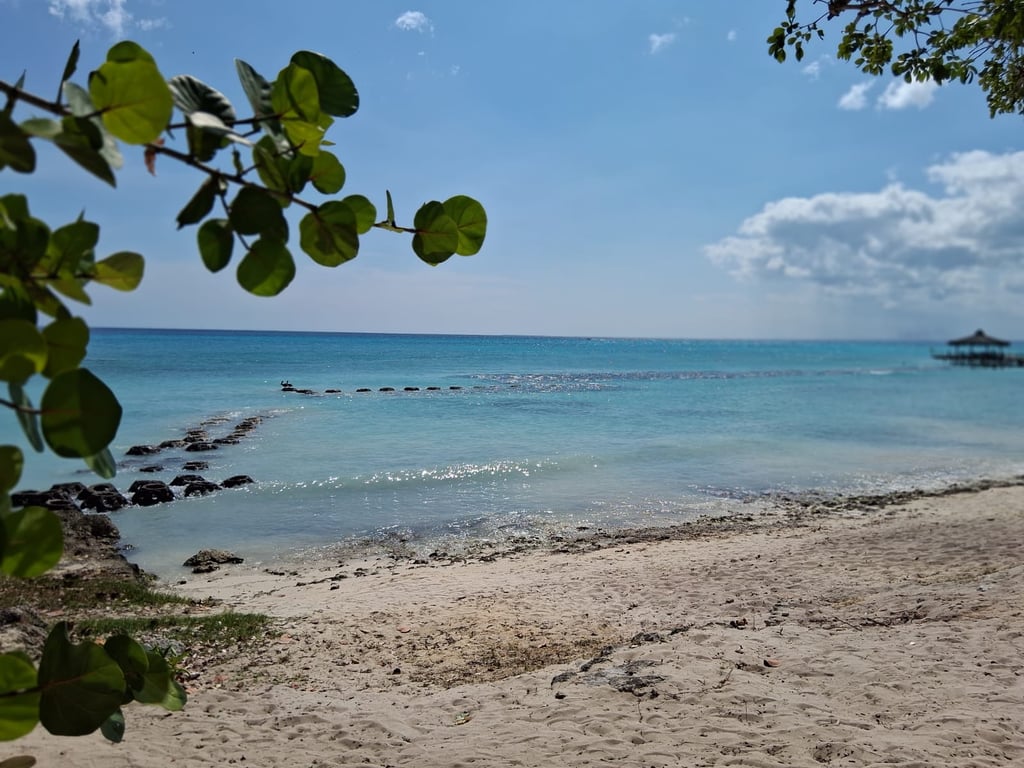

Bayahibe & La Romana (South Coast)
These beaches face the Caribbean Sea, not the Atlantic Ocean, so they’re usually free from seaweed, even in the summer.
Dominicus Beach in Bayahibe is a Blue Flag beach known for its calm, clear water, perfect for swimming and snorkeling.
Hotels in this area rarely report sargassum, and travelers often say it's one of the most reliable places to avoid seaweed any time of year. Looking for a stay? Find hotels in Bayahibe and La Romana on Hotels.com and compare options, reviews, and beachfront locations.
It's also a popular starting point for trips to Saona Island and Catalina Island, which is mostly sargassum-free too.
Barahona & Pedernales (Southwest Coast)
This region is more off the beaten path, but it has some of the cleanest and most beautiful beaches in the country, and very little to no sargassum.
Beaches like Bahía de las Águilas, Los Patos, and Playa San Rafael are protected by geography and far from the Atlantic currents that carry seaweed.
The area is remote, quiet, and ideal for travelers looking for natural beauty and adventure without crowds. Learn more
Puerto Plata, Sosúa & Cabarete (North Coast)
These beaches are on the Atlantic, but the ocean currents here are different. They usually bring less seaweed compared to the East Coast.
Sosúa and Puerto Plata have beautiful, swimmable waters and lots of local culture.
Cabarete is great for surfing and kiteboarding, and it also stays mostly clear of sargassum, even in summer.
Samaná Peninsula (Northeast Coast)
Samaná is one of the most scenic and tropical areas in the Dominican Republic, but it's important to know that some beaches here do get sargassum, especially in summer.
Beaches like Las Terrenas and El Portillo can see seaweed buildup depending on wind and ocean conditions.
Las Galeras and Playa Rincón are more protected and often stay clear, but not always.
Still, the region is rich in nature like waterfalls, h, making it a great destination overall. Read more.
✅How Do Resorts Handle Sargassum?
Worried about seaweed ruining your beach time? The good news is that many resorts in the Dominican Republic take active steps to manage sargassum and keep their beachfronts clean and guest-friendly. Here’s how they do it:
Daily Beach Cleaning
Most resorts use early morning cleaning crews to rake, collect, and remove seaweed before guests head to the beach. This routine helps maintain a clean, inviting shoreline throughout the day.
Specialized Machinery
Some larger resorts and hotels also use beach cleaning machines and tractors designed to collect seaweed quickly and efficiently, especially after heavy overnight buildup. This allows them to cover wide areas faster than with manual labor alone.
Floating Barriers at Sea
In areas with frequent sargassum, several resorts have installed floating barriers or seaweed containment booms in the water. These help block or redirect large mats of sargassum before they reach the shore.
Resort Pools and Other Amenities
Even if there’s some seaweed on the beach, you can still enjoy your vacation. Resorts offer beautiful pools, jacuzzis, outdoor bars, spa services, and daily entertainment. Staff are always ready to help and make sure your stay is relaxing and fun.
And don’t forget—the Dominican Republic is known for its warm, sunny weather almost every day of the year, so you’ll still have plenty of chances to enjoy the outdoors.
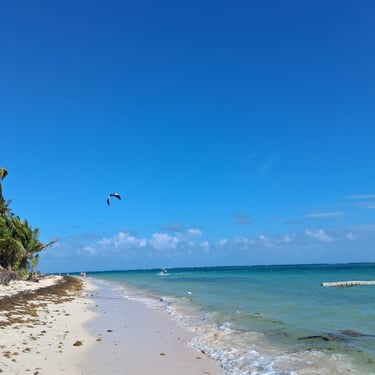
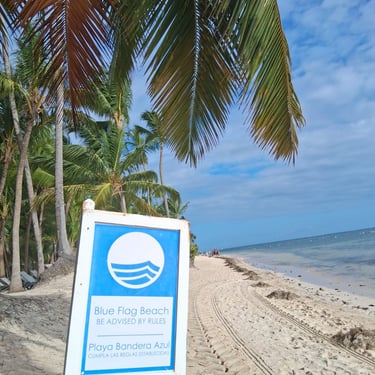
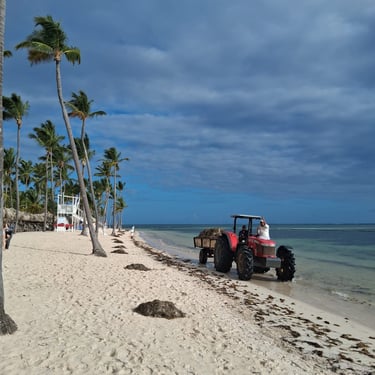
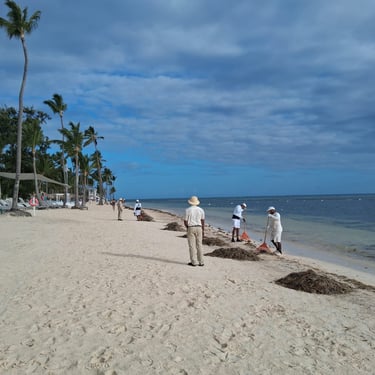
✅Tips for Travelers During Sargassum Season
✔️Check Sargassum Reports Before You Go
Websites like Sargassum Monitoring offer real-time updates on seaweed conditions across the Caribbean. You can also join Facebook groups like Dominican Republic Sargassum Seaweed Reports for daily photos, traveler experiences, and local tips. A quick check before your trip can help you choose the best beach days or even adjust your itinerary.✔️Book Your Stay in Low-Impact Areas
Some destinations, like Bayahibe and La Romana, are typically less affected by sargassum. If you're planning a beach-focused getaway, consider booking accommodations in these areas.✔️Pack Smart for the Unexpected
Bring the right gear to enjoy your trip, even if the seaweed shows up:Water Shoes – Perfect for walking through slippery or seaweed-covered areas.
Snorkeling Gear – Head out to deeper waters where sargassum is rarely a problem.
Pool Fun & Gadgets – When the beach is off-limits, your hotel pool becomes the main event! Check out our favorite pool gadgets to bring.
Don’t forget to review our Packing Essentials for the Dominican Republic so you’re prepared for any beach day curveballs.
✔️Try Alternative Beach Spots Near Punta Cana
If you’re staying in Punta Cana and the main beach is affected, don’t worry — there are stunning nearby options:Macao Beach – Known for its clear waters and natural beauty, often with less seaweed.
Isla Catalina and Isla Saona – Gorgeous offshore escapes that usually offer pristine waters and sargassum-free swimming.
✔️Enjoy Off-Beach Adventures
If the coastline isn’t picture-perfect, that’s your cue to explore inland. Hike lush trails, take a cultural tour, go shopping at local markets, or chase waterfalls.One must-visit spot? The stunning Blue Hole (Hoyo Azul) at Scape Park in Cap Cana. This natural cenote is famous for its vibrant turquoise water, surrounded by limestone cliffs and lush greenery — ideal for a refreshing swim and incredible photos. Book your excursion to Hoyo Azul and other top-rated tours on Viator before they sell out!
✔️Don’t Panic — Be Flexible
Sargassum is temporary and often varies from beach to beach, and even from morning to afternoon. Don’t assume all beaches are affected equally — many areas remain clear and beautiful even when others aren’t. If the beach looks rough in the morning, don’t stress — check back later, relax by the pool, or try something new. A little flexibility can turn a “seaweed situation” into a travel story worth telling. And don’t let it ruin your trip — there’s so much more to explore in the Dominican Republic!
While sargassum can be an inconvenience, it’s just one small part of the vibrant, diverse experience the Dominican Republic has to offer. By planning ahead and staying flexible, you can still enjoy gorgeous beaches, delicious food, and unforgettable adventures.
Don’t let sargassum hold you back, the Dominican Republic is waiting for you! Discover the best Punta Cana excursions and book your favorites today.
For more help planning your beach time, check out our guides to the Best Beaches and Watersports in the Dominican Republic and our Beach Safety Tips to stay safe and make the most of your days by the sea!
Explore the Dominican Republic with DR Simplified – Your Viator Travel Shop!
Discover the best excursions, cultural experiences, and adventure tours in the Dominican Republic, all handpicked for travelers like you! Whether you're looking for stunning beaches, historical sites, or thrilling activities, our Viator shop offers top-rated tours with trusted guides. Book with ease and make your trip unforgettable!
Terms and Conditions © All rights reserved 2025
Affiliate Disclaimer
Some links on DR Simplified are affiliate links. If you make a purchase or booking, we may earn a commission at no extra cost to you. Thanks for your support!


